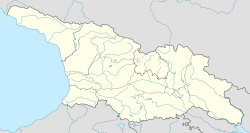Little White House
- See also Harry S. Truman Little White House in Key West, Florida.
Warm Springs Historic District | |
 The Little White House | |
| Location | Warm Springs, Georgia |
|---|---|
| Built | 1932 |
The Little White House, in the Warm Springs Historic District in Warm Springs, Georgia, was Franklin Delano Roosevelt's personal retreat. He first came to Warm Springs for treatment of his paralytic illness, and liked the area so much that, as Governor of New York, he had a home built on nearby Pine Mountain. The house was finished in 1932. Roosevelt kept the house after he became President, using it as a Presidential retreat.
The Little White House was the site of President Roosevelt's death. The house was opened to the public as a museum in 1948. A major attraction of the museum is the portrait that artist Elizabeth Shoumatoff was painting of him when he died, now known as the "Unfinished Portrait." It hangs near a finished portrait that Shoumatoff completed later from sketches and memory.
Little White House Historic Site is operated by the State of Georgia.
History
Residents of Georgia, particularly Savannah, Georgia, began spending vacations at Bullochville, Georgia in the late 18th century as a way to escape yellow fever, finding the number of warm springs in the vicinity of Bullochville very attractive. In the late 19th century traveling to the warm springs was attractive as a way to get away from Atlanta. Traveling by railroad to Durand, Georgia, they would then go to Bullochville. One of the places benefiting from this was the Meriwether Inn. Once the automobile became popular in the early 20th century, the tourists began going elsewhere, starting the decline of the Meriwether Inn.[1] [2]
In 1921 Franklin Delano Roosevelt contracted what was thought at the time to be polio. One of the few things that seemed to ease his pain was immersion in warm water, and while in said water to bathe and engage in physical exercise. His first time in Warm Springs, Georgia, was October 1924. He went to a resort in the town whose attraction was a permanent 88-degree natural spring, but whose main house was described as "ramshackle". Roosevelt bought the resort and the 1,700-acre (6.9 km2) farm surrounding it in 1927 (the resort would become known as the Roosevelt Warm Springs Institute for Rehabilitation). Five years later, after winning the presidency for the first time, in 1932 he built a small pine-paneled house near the facility, which he called the Little White House. In total, he made sixteen trips to the Little White House during his presidency, usually spending two to three weeks at a time, as it took a day to reach Warm Springs from Washington D.C. by train.[3]

The Little White House was a six-room structure made of Georgia pine. Three of the rooms were bedrooms: one for Roosevelt, one for his wife Eleanor Roosevelt, and one for his personal secretary. The other rooms were an entrance hall, a living room, and a kitchen. Access to the Little White House was from an unpaved road that now only exist in parts. The garage-servant's quarters was built in 1932, followed by the single-story frame cottage that served as a guesthouse in 1933, and finally a cottage for Georgia Wilkins in 1934.[4]
Roosevelt would use the Little White House as a base to replace Georgia politicians that refused to follow his policies. This was most notable in 1938 when Roosevelt tried and failed to have United States Senator Walter George replaced with a Roosevelt loyalist, even through both were Democrats.[4]
World War II did affect Roosevelt's time at the Little White House. The only year he did not go to the Little White House was 1942, as he was preoccupied by the beginnings of US involvement in World War II. It is believed that he vacationed as much as he did in 1943-1945 at the Little White House because his real love for vacations, sailing on the Atlantic, was too dangerous to do during wartime, even if it was just on inland waterways like the Chesapeake Bay or the Potomac River. One major change was that soldiers from Fort Benning were stationed at the Little White House to patrol the woods surrounding the farm.[5]
His last trip to the Little White House was on March 30, 1945. He felt he did not achieve enough rest at his Hyde Park home. According to some observers at Warm Springs, Roosevelt looked "ghastly". and his usual cordial waves to the residents were weak. Unlike his previous visits, he avoided the swimming pool he used to comfort himself in previous trips. On April 12, 1945, while at the Little White House, he complained about having a headache, and then slumped over. Roosevelt died two hours later.[6]
Most of Roosevelt's property was willed to Georgia Warm Springs Foundation, who gained control of all the properties in 1948 except for the Georgia Wilkins Cottage, which Wilkins lived in until her 1959 death. Both John F. Kennedy in 1960 and Jimmy Carter in 1976 used the property for their campaigns to become president; Carter even launched his campaign there.[4]
Today
Today the Little White House is part of Georgia's state park system. Much of it remains as it looked the day Roosevelt died, save for the Georgia Wilkins cottage. Items on display at the facility, besides the Unfinished Portrait, include his customized 1938 Ford convertible (in the bottom floor of the garage/servant house) and his stagecoach.[7] [4]
References
- ^ Georgia State Parks - History
- ^ Warm Springs Historic District NRHP nomination form
- ^ Walsh, Kenneth T. From Mount Vernon to Crawford (Hyperion, 2005) p.96,97
- ^ a b c d Warms Springs NRHP form
- ^ Walsh p.97-98
- ^ Walsh p.102-104
- ^ Georgia State Parks - Roosevelt's Little White House Historic Site

